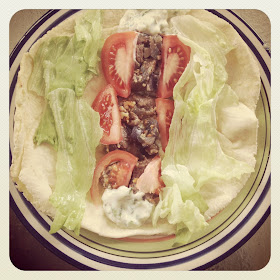Sometimes
during winter you just feel like a super hearty, starchy meat pie.
Unfortunately, whilst I can cook this for my respective other, I cannot eat it
without suffering some serious digestive problems from the gluten & milk
solids in the pastry. However, I can certainly post the recipe for others to
enjoy! Whilst the cooking process is around 1 hour for this lovely pie, the
manual labour is not intensive at all, as that hour consists of leaving the
chicken mixture to simmer on the stove and bake in the oven. Basically all you
have to do is cut up the chicken and potato. As I was running spectacularly
late the night I made this pie, I did not even consider adding more vegetables,
however you could add all means of ingredients to the pie, such as carrots,
celery, peas, sweet potato etc. There is
nothing quite like a warm, toasty pie to eat on a chilly winter’s night. Hurry
up and get baking before September comes!
INGREDIENTS
- 400-425g potatoes (such as sebago potatoes), peeled & cut into 2cm pieces
- 300g chicken breast, cut into even 3-4cm pieces
- 1 medium brown onion, finely chopped
- 2 garlic cloves, finely chopped
- 1 tablespoon fresh parsley, finely chopped
- 1 litre of chicken or vegetable stock
- 1 teaspoon curry powder
- 1 tablespoon coconut oil (in liquid form), plus extra to grease pie tin
- 2 sheets of reduced-fat puff pastry, thawed
COOKING
1. Preheat fan-forced oven to 200 degrees celsius.
2. Heat oil in a large saucepan over medium heat, adding garlic, onion and parsley. Stir well for 2 minutes or until onion is soft. Add chicken to the pan and cook, stirring often, for 5 minutes or until chicken is white in colour and cooked through. Add potato pieces, tossing to coat. Pour stock and curry powder into the pan and bring to the boil. When boiling, reduce to a simmer for 20 minutes, covered.
3. Meanwhile, grease a circular pie tin with coconut oil and gently place one thawed pastry sheet on the bottom of the tin. You may find that some of the pastry will cover half of the sides of the tin, this is ok. When the chicken mixture has simmered for 20 minutes, pour into the prepared pie tin, taking care to only pour in a quarter of the liquid stock. Cover with another thawed pastry sheet. Do not worry if some of the pastry folds over the tin, as it will shrink during baking.
4. Bake the pie in the preheated oven for 30-35 minutes or until pastry crust is golden brown. Serve warm.
Serves / 6
Total Preparation time / 15 minutes
Total Cooking time / 60 - 65 minutes
x E









